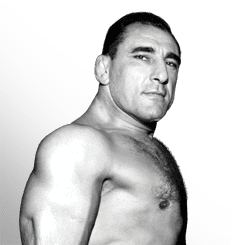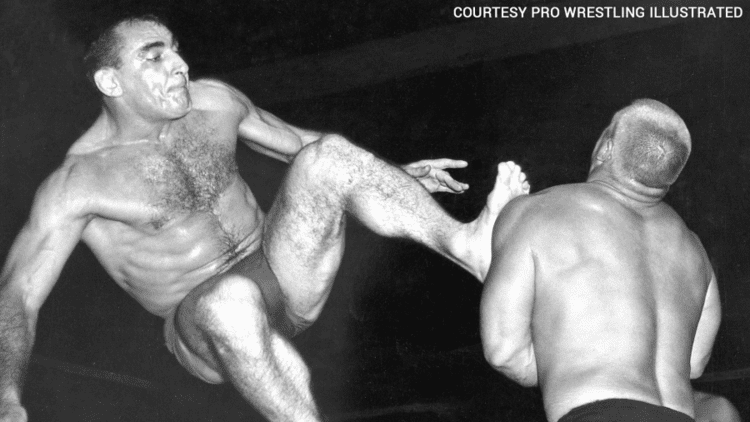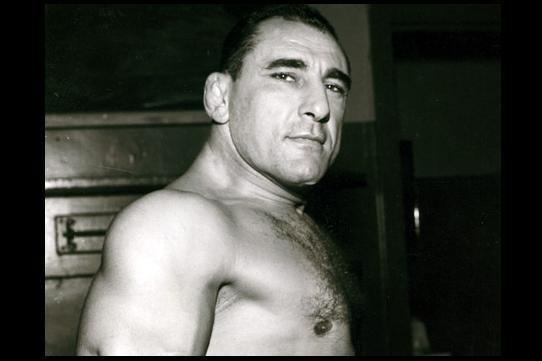Birth name Antonino Biasetton Name Antonino Rocca Billed height 6 ft 0 in (1.83 m) | Billed weight 220 lb (100 kg) Retired 1976 Debut 1942 | |
 | ||
Ring name(s) Antonino RoccaArgentina Rocca Died March 15, 1977, New York City, New York, United States | ||
Killer kowalski vs antonino rocca
Antonino Rocca (born Antonino Biasetton, 13 April 1921 – 15 March 1977) was an Italian Argentinian professional wrestler.
Contents
- Killer kowalski vs antonino rocca
- The top ten moves of antonino rocca
- Professional wrestling career
- Capitol Wrestling Corporation 1949mid 1970s
- Appearances in Japan late 1960searly 1970s
- World Wrestling Council 19731976
- Gorilla Monsoon vs Andr the Giant
- Death
- In popular culture
- In wrestling
- Championships and accomplishments
- References

Rocca was a popular fan favorite and in some cities with both Italian American and especially Hispanic audiences, his following was exceptionally large and loyal. He also possessed Argentine citizenship and had a love for opera and was apparently described as having an excellent – if untrained – singing voice. Maestro Arturo Toscanini, a professional wrestling fan, was good friends with Rocca.

Rocca was posthumously inducted into the WWF Hall of Fame class of 1995 and the Wrestling Observer Newsletter Hall of Fame in 1996.

The top ten moves of antonino rocca
Professional wrestling career

As a soccer and rugby player when he moved to Argentina, before World War II, and an overall athlete, Rocca was known for his unique, acrobatic, off-the-ground, flying wrestling style, which he probably invented, wowing audiences with his dazzling aerial maneuvers. He was responsible for the revival of the New York City Metropolitan-Area territory in the late 1940s, which would eventually become part of the modern day WWE. Rocca became one of the most well-known professional wrestlers in America during the golden age of television. He also had a successful tag team career, forming a popular tandem with Miguel Pérez. The two, along with their heel (villain) opponents, drew large crowds to Madison Square Garden on a regular basis. Rocca had an uninterrupted seven-year run of headlining or co-headlining every main event at the Garden.

Rocca started his American professional wrestling career in 1948–1949 in Texas, and his earliest days wrestling in the business are still not known. He had been trained by the legendary legitimate-wrestler and former world's heavyweight champion Stanislaus Zbyszko in Argentina. In the early 1950s, he held two regionally recognized versions of professional wrestling's world heavyweight singles championship while still headlining nationwide, frequently in territories where other wrestlers were the recognized champs. He was even described by then National Wrestling Alliance (NWA) generally recognized champion Pat O'Connor as the "uncrowned champion" in New York City, and it was O'Connor who, on television, challenged Rocca to a match (not held in New York City) to determine who was better.
Capitol Wrestling Corporation (1949–mid 1970s)

In 1949, Rocca started wrestling in the New York City-area territory for Joseph Raymond "Toots" Mondt, and the Johnston family of promoters, which controlled wrestling at Madison Square Garden and Mondt, who owned Rocca's exclusive contract. The territory had been one of the four largest-grossing areas up until the mid-1930s New York, and would later be run by Capitol Wrestling Corporation (CWC, now WWE). He is generally considered as the box-office draw that helped bring wrestling back to Madison Square Garden, on a regular basis, for the first time since 1938.
Rocca was so popular that he was being used as a main eventer by promoters throughout the United States and Canada, who booked him through Mondt, who was the co-founder of the booking office that provided the talent for the Garden and other venues. Rocca formed a tag team with Jose Miguel Pérez in 1957 and they were hugely successful as such. Together, they captured the NWA Capitol World Tag Team Championship, which was the top tag team title used in CWC, and like so many other titles, was a regional one. They were never defeated after winning this title, but the appellation was abandoned after about five years. Perez was videotaped with his original championship belt from that title in a 1987 30th anniversary tribute, after Rocca's death.
In 1963, the Capitol promotion may have left the NWA when it was renamed the World Wide Wrestling Federation (WWWF). WWE history lists a tournament final to crown the first WWWF World Heavyweight Champion as Buddy Rogers over Rocca on 29 April 1963 in Rio de Janeiro, Brazil, but this tournament is fictitious. Rogers had legitimately held the NWA World Heavyweight Championship, but lost that title to Lou Thesz in Toronto earlier in 1963 in a match – and rematch – ignored by the New York City and Chicago promoters.
In 1959 and into 1960, Rocca worked briefly with veteran Kola Kwariani and under Jack Pfefer, controversial promoter, impresario and genuine manager of professional wrestlers, took effective control of the Garden's wrestling office. Kwariani had just broken away from his partnership with Vince McMahon, Sr. Rocca then set the post-World War II record for wrestling-attendance at Madison Square Garden's 49th–50th Street location, drawing 21,950 fans in a singles match against an obscure wrestler named "The Amazing Zuma", aka "Argentina Zuma", on 2 January 1960, as was reported by The New York Times. This was part of a series of three matches between the two held during a four-month period, when the pair earlier drew, on another night, almost as many fans to the Garden. The Times called the largest turnout of these three matches the all-time record for wrestling attendance at Madison Square Garden, although there is some question whether a Jim Londos-led event in the 1930s drew a few hundred more fans. Rocca had also been provided with new professional wrestler Bruno Sammartino as a tag team partner and second-banana in tag team matches. However, when this team failed to sell-out the Garden, the pair was split up to wrestle each other in the hopes that business would pick up, but it did not. Eventually McMahon Sr. took the New York territory back and built it by first featuring "Nature Boy" Buddy Rogers and then, a few years later, the by-then charismatic Sammartino as its champion.
After a demotion, and with the arrival of Buddy Rogers as the featured star at the Garden in 1961, within a few years Rocca left the WWWF and briefly set up a competing promotion (supported by Jim Crockett, Sr. and others) based at the Sunnyside arena in Queens, New York. It is believed to have failed and it ceased operations.
In the mid-1970s, he teamed up with Vince McMahon to handle the color commentary on the WWWF's weekly television show. He provided color commentary on WWF Championship Wrestling and All-Star Wrestling from 1972-76.
Appearances in Japan (late 1960s–early 1970s)
Rocca was involved as a professional wrestler, but also as a referee in Japan during these years. He refereed a number of matches for the Japan Pro Wrestling Association (JPA), and later followed Antonio Inoki to New Japan Pro Wrestling in 1972. Inoki (born Kanji) was said to take his stage name from him.
World Wrestling Council (1973–1976)
There is not much information on where Rocca worked in the following ten years, but it is known that in 1973, he joined the World Wrestling Council (WWC) in Puerto Rico with partner Miguel Pérez. They captured the defunct WWC North American Tag Team Championship on 11 September 1976 by defeating Los Infernos. They lost the championship to Higo Hamaguchi and Gordon Nelson on 16 October.
Gorilla Monsoon vs. André the Giant
On February 25, 1977, in his last days, Rocca appeared in the WWWF, officiating a boxing match between Gorilla Monsoon and André the Giant at the Madison Square Garden.
Death
Rocca died on 15 March 1977, at Roosevelt Hospital in New York City after complications following a urinary infection. His funeral was attended by thousands and made the front page of all NYC newspapers.
